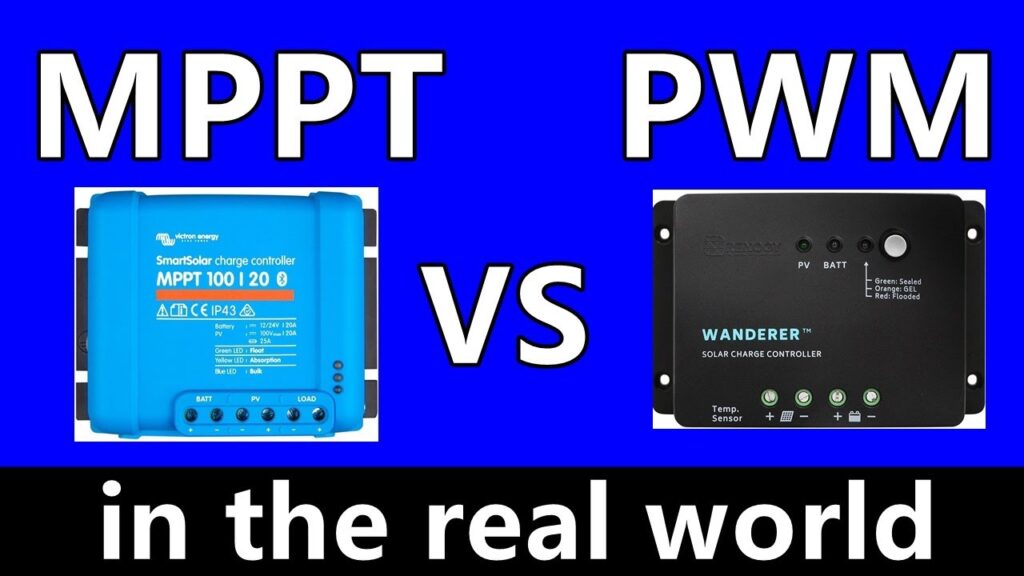When you put together a solar power kit, most folks zoom in on the panels and the batteries because those are the visible bits. Yet a tiny piece of hardware—the solar charge controller—steers all that electricity, deciding how much gets sent into storage and when. In short, it guards your batteries and keeps things running smoothly.
Anúncios
Two popular controller designs rule the market: MPPT (Maximum Power Point Tracking) and the tried-and-true PWM (Pulse Width Modulation). The choice between them can lift, drag, or barely nudge your system’s efficiency and wallet impact, so it pays to know both.
In the lines that follow, we break down what each type actually does and point you toward the one that fits your home, farm, or startup in India.
What Is a Solar Charge Controller?

Anúncios
A solar charge controller is a small box that sits between your panels and your batteries and its job is to babysit the electricity zipping back and forth. It throttles the flow so your batteries never gulp too much power in bright sun, and it blocks reverse drainage once the panels go dark.
Letting panels and batteries talk without a controller is like pushing a car into gear and hoping the brakes figure it out—things end badly. So, think of the controller as both insurance and the silent traffic cop keeping your solar system safe and efficient.
Also Read Powering India’s Future: Understanding the National Solar Mission
Solar Charge Controllers: What You Should Know
Two main controller types run most home and small-business solar systems:
Anúncios
1. PWM (Pulse Width Modulation)
- Low-cost, straightforward tech you find in older grids
- Durable design with few moving parts
- Hands-down winner if panel and battery voltages are close
2. MPPT (Maximum Power Point Tracking)
- Hi-tech gadget that squeezes every last watt
- Constantly re-weights input voltage to suit battery needs
- Indispensable on big arrays or when panels sit way above batteries
How PWM Charge Controllers Work
A PWM unit links panel and battery almost directly. It flicks the connection on and off so voltage stays in the sweet spot. That trick is easy to build, but good luck chasing top efficiency.
Picture an 18-volt panel feeding a 12-volt battery. The controller chops the extra voltage down. Instead of charging cells, the leftover power turns to heat and vanishes.
Advantages of PWM controllers:
- They cost very little.
- Installation is quick, and maintenance stays easy.
- They suit small, off-grid solar kits.
Drawbacks of PWM controllers:
- Efficiency lags at only 70 to 80 percent.
- Performance drops in cold or cloudy weather.
- They need solar panels and batteries that match closely.
How MPPT Charge Controllers Work
MPPT units use smart electronics. They constantly find the sweet spot, the maximum-power point, where panels make the most power. Then they turn unused voltage into extra current, sending it to the battery faster and more efficiently.
As a result, more energy lands in the battery, especially when the air is cool or sunlight is weak.
Pros of MPPT:
- Highly efficient, sometimes reaching 98%.
- Squeezes out extra watts from every solar panel.
- Fits large, grid-tied or commercial setups perfectly.
- Handles long cable runs without losing much voltage.
- Adapts quickly to India’s changeable skies and seasons.
Cons of MPPT:
- Unit price and installation usually sting the wallet.
- Wiring can be a little trickier for do-it-yourselfers.
- Hot days may call for extra cooling or airflow.
MPPT vs. PWM: Side-by-Side Comparison
| Feature | PWM Controller | MPPT Controller |
|---|---|---|
| Cost | Cheaper | More expensive |
| Efficiency | 70–80% | 95–98% |
| Best Use Case | Small systems, low budget | Medium to large systems |
| Performance in Shade/Cold | Poor | Excellent |
| Compatibility | Same voltage panel/battery | Higher panel voltage allowed |
| Power Loss | More | Less |
| Lifespan | 5–7 years | 10+ years |
When Should You Choose a PWM Controller?
- You are building a small solar setup for basic needs (lights, fans, simple pumps).
- The budget leaves no room for extras.
- Panel and battery voltages match (12V with 12V, say).
- Your skies are mostly clear and shade is rare.
Example:
A village home in Rajasthan could rely on a PWM controller with its small 12V panel and battery, keeping bulbs lit and phones charged without fuss or extra cost.
When Is an MPPT Controller the Right Choice for You?
- When your system sits around 1 kW or bigger
- When squeezing every single watt matters
- When panel voltage often sits above battery voltage
- When your local weather swings from bright to overcast
Example:
A 2 kW rooftop setup on a Himachal bungalow reaps higher cold-weather gains with an MPPT unit.
Solar Charge Controller Prices in India (2025)
| Type | Power Capacity | Approx. Price (INR) |
|---|---|---|
| PWM | 10 A–30 A | ₹800–₹2,500 |
| MPPT | 20 A–60 A | ₹4,000–₹15,000 |
Final cost depends on brand and extras; Luminous, Sukam, Microtek, and EAPRO lead the pack.
Installation Tips
- Pick a controller rated for your panel’s total wattage.
- Hire a skilled technician, especially for MPPT gear.
- Look for at least two years warranty.
- Give the unit room to breathe; good ventilation extends life.
Frequently Asked Questions
Q1. Can I swap my PWM for an MPPT later?
Yes, but expect wiring tweaks and compatibility checks.
Q2. Does MPPT beat PWM every time?
For high-voltage or rapidly shifting light, yes.
Q3. What is the lifespan of a charge controller?
PWM units usually run for about five to seven years, while well cared-for MPPT models can serve ten to twelve.
Q4. Can I use MPPT for a small solar system?
You can, though the return on extra cost may shrink unless you plan to add panels later.
Q5. Which brands offer good MPPT controllers in India?
Reliable names include Luminous, Victron, EAPRO, and Sukam.
Conclusion
Choosing the right solar charge controller is as vital as picking high-quality panels or batteries. For compact, budget-conscious setups, a simple PWM controller keeps things steady. If you seek peak efficiency, durability, and future expandability, reach for an MPPT model.
Think of it this way—a good MPPT controller acts like a savvy foreman who harvests every stray watt from your roof. For homes facing routine outages or aiming for a complete solar shift in India, that extra cost can quickly pay off.
Still on the fence? Have your installer crunch the figures so you can see how each option stacks up for your project.
Author- Ayush










